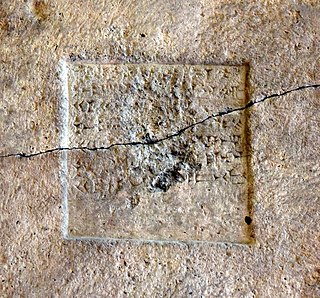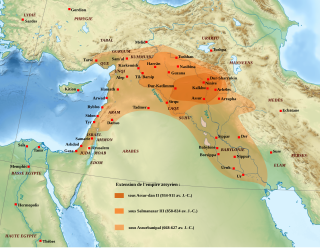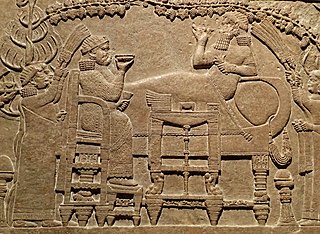
Tiglath-Pileser III was the king of the Neo-Assyrian Empire from 745 BC to his death in 727. One of the most prominent and historically significant Assyrian kings, Tiglath-Pileser ended a period of Assyrian stagnation, introduced numerous political and military reforms and more than doubled the lands under Assyrian control. Because of the massive expansion and centralization of Assyrian territory and establishment of a standing army, some researchers consider Tiglath-Pileser's reign to mark the true transition of Assyria into an empire. The reforms and methods of control introduced under Tiglath-Pileser laid the groundwork for policies enacted not only by later Assyrian kings but also by later empires for millennia after his death.
Shalmaneser IV was the king of the Neo-Assyrian Empire from 783 BC to his death in 773 BC. Shalmaneser was the son and successor of his predecessor, Adad-nirari III, and ruled during a period of Assyrian decline from which few sources survive. As such his reign, other than broad political developments, is poorly known. Shalmaneser's time was marked both by an increase in the power held by Assyrian officials relative to that of the king and Assyria's enemies growing increasingly powerful. Most of Shalmaneser's military efforts were spent warring against the Kingdom of Urartu in the north, which during this time was reaching the peak of its power.

Nimrud is an ancient Assyrian city located in Iraq, 30 kilometres (20 mi) south of the city of Mosul, and 5 kilometres (3 mi) south of the village of Selamiyah, in the Nineveh Plains in Upper Mesopotamia. It was a major Assyrian city between approximately 1350 BC and 610 BC. The city is located in a strategic position 10 kilometres (6 mi) north of the point that the river Tigris meets its tributary the Great Zab. The city covered an area of 360 hectares. The ruins of the city were found within one kilometre (1,100 yd) of the modern-day Assyrian village of Noomanea in Nineveh Governorate, Iraq.
Ashur-nirari V was the king of the Neo-Assyrian Empire from 755 BC to his death in 745 BC. Ashur-nirari was a son of Adad-nirari III and succeeded his brother Ashur-dan III as king. He ruled during a period of Assyrian decline from which few sources survive. As such his reign, other than broad political developments, is poorly known.

Adad-nīrārī III was a King of Assyria from 811 to 783 BC. Note that this assumes that the longer version of the Assyrian Eponym List, which has an additional eponym for Adad-nīrārī III, is the correct one. For the shorter eponym list the ascension year would be 810 BC.
Adad-nārārī I, rendered in all but two inscriptions ideographically as mdadad-ZAB+DAḪ, meaning "Adad (is) my helper," was a king of Assyria during the Middle Assyrian Empire. He is the earliest Assyrian king whose annals survive in any detail. Adad-nārārī I achieved major military victories that further strengthened Assyria. In his inscriptions from Assur he calls himself son of Arik-den-ili, the same filiations being recorded in the Nassouhi kinglist. He is recorded as a son of Enlil-nirari in the Khorsabad kinglist and the SDAS kinglist, probably in error.

Shammuramat, also known as Sammuramat or Shamiram and Semiramis, was a powerful queen of the Neo-Assyrian Empire. Beginning her career as the primary consort of the king Shamshi-Adad V, Shammuramat reached an unusually prominent position in the reign of her son Adad-nirari III. Though there is dispute in regard to Shammuramat's formal status and position, and if she should be considered a co-regent, it is clear that she was among the most powerful and influential women of the ancient Near East; she is the only known Assyrian queen to have retained her status as queen after the death of her husband and the only known ancient Assyrian woman to have partaken in, and perhaps even led, a military campaign.
Arik-den-ili, inscribed mGÍD-DI-DINGIR, “long-lasting is the judgment of god,” was King of Assyria c. 1317–1306 BC, ruling the Middle Assyrian Empire. He succeeded Enlil-nirari, his father, and was to rule for twelve years and inaugurate the tradition of annual military campaigns against Assyria's neighbors.

The Neo-Assyrian Empire was the fourth and penultimate stage of ancient Assyrian history. Beginning with the accession of Adad-nirari II in 911 BC, the Neo-Assyrian Empire grew to dominate the ancient Near East throughout much of the 8th and 7th centuries BC, becoming the largest empire in history up to that point. Because of its geopolitical dominance and ideology based in world domination, the Neo-Assyrian Empire is by many researchers regarded to have been the first world empire in history. It influenced other empires of the ancient world culturally, governmentally, and militarily, including the Babylonians, the Achaemenids, and the Seleucids. At its height, the empire was the strongest military power in the world and ruled over all of Mesopotamia, the Levant and Egypt, as well as parts of Anatolia, Arabia and modern-day Iran and Armenia.

The Middle Assyrian Empire was the third stage of Assyrian history, covering the history of Assyria from the accession of Ashur-uballit I c. 1365 BC and the rise of Assyria as a territorial kingdom to the death of Ashur-dan II in 912 BC. The Middle Assyrian Empire was Assyria's first true period of ascendancy as an empire, although Assyrian kings had existed from perhaps as early as the 25th century BC, and from the 21st century BC Assyria had controlled trading colonies in Anatolia and had economic and military influence in Southern Mesopotamia, and from the late 19th century BC had been an integral part of the "Empire of Shamsi-Adad", sometimes called the Old Assyrian Empire. Though the empire experienced successive periods of expansion and decline, it remained the dominant power of Mesopotamia and often the entirety of West Asia throughout the period. In terms of Assyrian history, the Middle Assyrian period was marked by important social, political and religious developments, including the rising prominence of both the Assyrian king and the Assyrian national deity Ashur.

Adad-šuma-uṣur, inscribed dIM-MU-ŠEŠ, meaning "O Adad, protect the name!," and dated very tentatively c. 1216–1187 BC, was the 32nd king of the 3rd or Kassite dynasty of Babylon and the country contemporarily known as Karduniaš. His name was wholly Babylonian and not uncommon, as for example the later Assyrian King Esarhaddon had a personal exorcist, or ašipu, with the same name who was unlikely to have been related. He is best known for his rude letter to Aššur-nirari III, the most complete part of which is quoted below, and was enthroned following a revolt in the south of Mesopotamia when the north was still occupied by the forces of Assyria, and he may not have assumed authority throughout the country until around the 25th year of his 30-year reign, although the exact sequence of events and chronology remains disputed.

The Saba'a Stele, also known as the Saba'a Inscription, is a boundary stone inscription of the reign of Adad-nirari III discovered in 1905 in two pieces in Saba'a, Sanjak of Zor, south of the Sinjar Mountains in modern Syria. It is the primary source for the military campaigns of Adad-nirari III.

Irhuleni was King of Hamath. He led a coalition against the Assyrian expansion under Shalmaneser III, alongside Hadadezer of Damascus. This coalition succeeded in 853 BC in the Battle of Qarqar a victory over the Assyrians, halting their advance to the west for two years. Later Irhuleni maintained good relations with Assyria. His son was, in Luwian, Uratami.
Nimrud is an ancient city in modern Iraq.

Assyrian sculpture is the sculpture of the ancient Assyrian states, especially the Neo-Assyrian Empire of 911 to 612 BC, which was centered around the city of Assur in Mesopotamia which at its height, ruled over all of Mesopotamia, the Levant and Egypt, as well as portions of Anatolia, Arabia and modern-day Iran and Armenia. It forms a phase of the art of Mesopotamia, differing in particular because of its much greater use of stone and gypsum alabaster for large sculpture.

The Queens' Tombs at Nimrud are a set of four tombs discovered by Muzahim Hussein at the site of what was once the ancient Assyrian city of Nimrud. Once the capital of the Neo-Assyrian Empire, Nimrud was located on the East bank of the Tigris river, in what would be modern day Northern Iraq. Nimrud became the second capital of the Assyrian empire during the ninth century BCE, under Assurnasirpal II. Assurnasirpal II expanded the city and built one of the most significant architectural achievements at Nimrud, the Northwest Palace––bētānu in Assyrian. The palace was the first of many built by Neo-Assyrian rulers, and it became a template for later palaces. During an excavation of the Northwest Palace in 1988, the Queen's Tombs were discovered under the Southern, domestic wing. All four tombs discovered within the palace were built during the ninth and eighth centuries and were primarily constructed of the mudbrick, baked brick, and limestone ––materials commonly used in Mesopotamian architecture. The architecture of the tombs as well as the Northwest Palace within which they are housed provide historical insight into the Assyrian Empire's building techniques. The most notable items found within the queens' tombs included hundreds of pieces of fine jewelry, pottery, clothing, and tablets. These objects crafted by Neo-Assyrian artists would later allow archaeologists to build on their understanding of Neo-Assyrian goldsmithing techniques. Each tomb was built in advance of a queen's death and construction began as early as the 9th century under Assurnasirpal II and continued under Shalmaneser III.

Hama was a queen of the Neo-Assyrian Empire as the primary consort of Shalmaneser IV. Historical records reveal next to nothing about Hama, and the vast majority of the information known about the queen comes from studies on her skeletal remains and the contents of the bronze coffin she was buried in, discovered by modern researchers in 1988 but not securely identified as Hama until 2017. Hama's skeleton indicates that she died at a young age, at some point between the age of 18 and 20, and that she suffered from some mild health issues, including gingivitis, dental plaque and chronic sinusitis.

The Tell al-Rimah stela or the Stele of Adad-nirari III is a victory stele of Adad-nirari III which may include a reference to an early king of Samaria as "Jehoash the Samarian" which would be the first cuneiform mention of Samaria by that name.

The queen of the Neo-Assyrian Empire was the consort of the Neo-Assyrian king. Though the queens derived their power and influence through their association with their husband, they were not pawns without political power. The queens oversaw their own, often considerable, finances and owned vast estates throughout the empire. To oversee their assets, the queens employed a large administrative staff headed by a set of female administrators called šakintu. Among the duties of the queens were religious responsibilities and overseeing parts of the royal palaces; their role as "rulers of the domestic realm" is reflected in their title as "Women of the Palace". The power and influence of the queens was increased further under the Sargonid dynasty (722–609 BC), when they more frequently appear in artwork and large military units directly subservient to the queen were created.

Mullissu-mukannishat-Ninua was a queen of the Neo-Assyrian Empire as the primary consort of Ashurnasirpal II. She was probably also the mother of his son and successor Shalmaneser III. Mullissu-mukannishat-Ninua is only known from her tomb, discovered in Nimrud in 1989. She was the daughter of the "great cupbearer" Ashur-nirka-da’’inni and as such probably belonged to the Assyrian aristocracy before she became queen.















